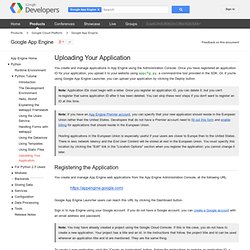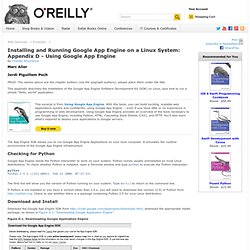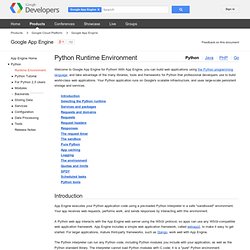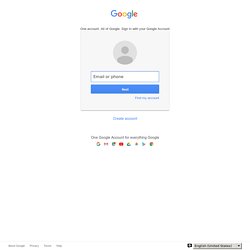

Configuring with app.yaml - Python. Using Static Files - Python. Blobstore Python API Overview - Python. Welcome to webapp2! — webapp2 v2.5.1 documentation. Uploading Your Application. You create and manage applications in App Engine using the Administration Console.

Once you have registered an application ID for your application, you upload it to your website using appcfg.py, a command-line tool provided in the SDK. Or, if you're using Google App Engine Launcher, you can upload your application by clicking the Deploy button. Note: Application IDs must begin with a letter. Once you register an application ID, you can delete it, but you can't re-register that same application ID after it has been deleted. You can skip these next steps if you don't want to register an ID at this time. Note: If you have an App Engine Premier account, you can specify that your new application should reside in the European Union rather than the United States.
Hosting applications in the European Union is especially useful if your users are closer to Europe than to the United States. Registering the Application Sign in to App Engine using your Google account. Uploading the Application. Installing and Running Google App Engine on a Linux System: Appendix D - Using Google App Engine. PROD: The names above are the chapter authors (not the epigraph authors); please place them under the title.

This appendix describes the installation of the Google App Engine Software Development Kit (SDK) on Linux, plus how to run a simple “Hello, world” application. The App Engine SDK allows you to run Google App Engine Applications on your local computer. It simulates the runtime environment of the Google App Engine infrastructure. Google App Engine needs the Python interpreter to work on your system. Python comes usually preinstalled on most Linux distributions. Python Python 2.5.2 (r252:60911, Feb 22 2008, 07:57:53) ... The first line will show you the version of Python running on your system. If Python is not installed or you have a version other than 2.5.x, you will need to download this version (2.5) of Python from Check to see whether there is a package containing Python 2.5 for your Linux distribution. Google Apps for Business - Business Solutions & Collaboration Tools.
Introduction - Python. NDB Cheat Sheet - Google Docs. Python - Static files application_readable usage. Google App Engine. Welcome to Google App Engine for Python!

With App Engine, you can build web applications using the Python programming language, and take advantage of the many libraries, tools and frameworks for Python that professional developers use to build world-class web applications. Your Python application runs on Google's scalable infrastructure, and uses large-scale persistent storage and services. Introduction App Engine executes your Python application code using a pre-loaded Python interpreter in a safe "sandboxed" environment.
Your app receives web requests, performs work, and sends responses by interacting with this environment. A Python web app interacts with the App Engine web server using the WSGI protocol, so apps can use any WSGI-compatible web application framework. The Python interpreter can run any Python code, including Python modules you include with your application, as well as the Python standard library. Selecting the Python runtime You specify the runtime element in app.yaml. Appengine main page.
One account.

All of Google. Sign in with your Google Account Find my account Forgot password? Sign in with a different account Create account One Google Account for everything Google.